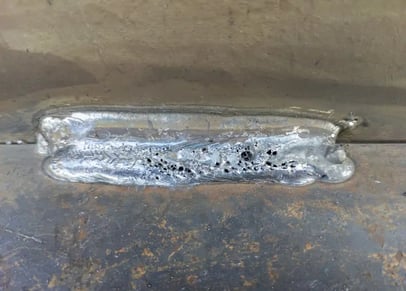How to Recognize What is Porosity in Welding and Improve Your Method
How to Recognize What is Porosity in Welding and Improve Your Method
Blog Article
Porosity in Welding: Identifying Common Issues and Implementing Ideal Practices for Prevention
Porosity in welding is a pervasive issue that often goes undetected till it triggers considerable problems with the honesty of welds. This typical problem can compromise the toughness and toughness of bonded frameworks, positioning safety threats and causing costly rework. By recognizing the source of porosity and applying reliable avoidance methods, welders can considerably boost the high quality and reliability of their welds. In this conversation, we will certainly explore the vital aspects adding to porosity development, examine its damaging effects on weld efficiency, and talk about the ideal methods that can be taken on to reduce porosity event in welding procedures.
Common Causes of Porosity

One more frequent offender behind porosity is the existence of pollutants on the surface of the base metal, such as oil, grease, or rust. When these contaminants are not effectively removed before welding, they can evaporate and come to be entraped in the weld, triggering flaws. Moreover, making use of dirty or damp filler products can present pollutants into the weld, adding to porosity concerns. To mitigate these typical sources of porosity, thorough cleansing of base steels, proper shielding gas selection, and adherence to optimal welding parameters are vital methods in accomplishing high-grade, porosity-free welds.
Effect of Porosity on Weld Top Quality

The presence of porosity in welding can considerably jeopardize the architectural honesty and mechanical residential or commercial properties of welded joints. Porosity develops spaces within the weld metal, weakening its total stamina and load-bearing ability. These gaps serve as tension concentration factors, making the weld a lot more prone to breaking and failing under applied lots. Furthermore, porosity can decrease the weld's resistance to deterioration and other ecological elements, even more decreasing its longevity and efficiency.
Welds with high porosity degrees tend to display lower influence stamina and lowered capability to flaw plastically prior to fracturing. Porosity can hinder the weld's capability to successfully transmit forces, leading to premature weld failing and potential security risks in crucial structures.
Best Practices for Porosity Prevention
To improve the architectural integrity and top quality of welded joints, what certain actions can be applied to lessen the incident of porosity throughout the welding procedure? Porosity avoidance in welding is critical to make certain the honesty and toughness of the final weld. One reliable method appertains cleaning of the base metal, getting rid of any type of contaminants such as corrosion, oil, paint, or wetness that can cause gas entrapment. Making sure that the welding devices is in good problem, with clean consumables and appropriate gas circulation rates, can likewise considerably lower porosity. In addition, keeping a steady arc and managing the welding parameters, such as voltage, current, and travel speed, aids develop a consistent weld pool that decreases the risk of gas entrapment. Making use of the correct welding method for the details material being bonded, such as readjusting the welding angle and gun setting, can better avoid porosity. Normal inspection of welds and instant discover this removal of any kind of issues determined throughout the welding procedure are important practices to avoid porosity and create top notch welds.
Relevance of Appropriate Welding Methods
Carrying out correct welding methods is extremely important in making certain the structural stability and high quality of welded joints, constructing upon the structure of effective porosity prevention measures. Extreme warmth can lead to increased porosity due to the entrapment of gases in the weld pool. Furthermore, utilizing the ideal welding parameters, such as voltage, existing, and travel rate, is vital for accomplishing audio welds with very little porosity.
Additionally, the choice of welding process, whether it be MIG, TIG, or stick welding, must straighten with the certain requirements of the project to ensure optimal outcomes. Appropriate cleansing and preparation of the base steel, along with picking the best filler material, are also vital parts of skilled welding techniques. By adhering to these finest practices, welders can lessen the risk of porosity development and produce premium, structurally sound welds.

Testing and High Quality Control Actions
Quality assurance measures play a crucial duty in validating the honesty and integrity of welded joints. Examining treatments are important to detect click now and stop porosity in welding, guaranteeing the strength and toughness of the last product. Non-destructive testing methods such as ultrasonic testing, radiographic screening, and visual inspection are commonly employed to identify possible issues like porosity. These methods enable for the evaluation of weld quality without jeopardizing the integrity over at this website of the joint. What is Porosity.
Post-weld examinations, on the various other hand, assess the final weld for any type of problems, including porosity, and verify that it satisfies specified criteria. Executing a comprehensive top quality control strategy that consists of complete screening treatments and evaluations is extremely important to decreasing porosity problems and making certain the overall high quality of welded joints.
Final Thought
Finally, porosity in welding can be a typical problem that affects the quality of welds. By determining the common reasons for porosity and carrying out ideal practices for avoidance, such as appropriate welding strategies and screening steps, welders can ensure premium quality and trusted welds. It is necessary to prioritize prevention methods to minimize the occurrence of porosity and preserve the integrity of bonded frameworks.
Report this page